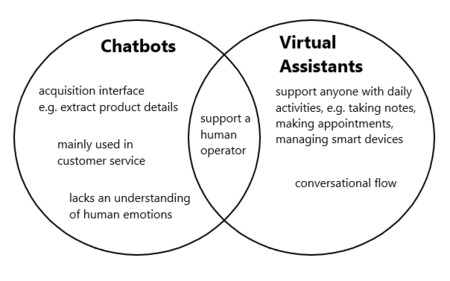
Do you like filling out a contact form online and waiting 24-48 hours to get a response? How do you feel when calling the trunk line of a company and waiting 5-10 minutes just to get a hold of the right person on the other line? Nowadays it is important for companies and services to appeal to a modern customer. Thanks to the fifth industrial revolution (the AI revolution), we are so used to immediate access to information and instant gratification.
So, how can companies address this growing need to accommodate a modern customer? Simple: they develop a Chatbot.
Defining a Chatbot
Most people will remember “Cleverbot,” a web application that uses AI to have real-time conversations with human users. It went online in 1997. Today, a Chatbot is a computer program that can have human-like conversations with a user by sending and receiving text messages. They work like a messaging app, in which input comes from a human user and the program will translate this based on its code to generate an output for the user to read. They are specifically programmed to respond like another human. Thanks to the incredible popularity of messaging apps, these are intuitive and can be implemented on websites or as web-based applications. They are currently being used to automate various business processes, especially repetitive tasks that require simple input. Answering questions from curious customers on the company’s website is just one of their uses.
In a survey conducted by Oracle, 80% of its participants have already implemented or will start implementing chatbots by 2020. 42% of its participants believe automation technologies in certain areas such as sales, marketing, and customer service, will improve customer experience the most while 48% said that they are already using automation technology for these business functions, with 40% planning to implement some form of automated technology by 2020. Even though complete automation is not feasible, 29% of customer service positions in the US could be automated through chatbots and other tech, according to Public Tableau. We estimate this translates to $23 billion in savings.
Simple vs. Advanced
Chatbots fall on a spectrum of Artificial Intelligence, which means that they can be as simple or complex as their developer intends them to be. Simple Chatbots require a specific input and those will result in a specific output, not much room for creativity or misspelling, but also not much need for AI. In contrast, the more advanced programs are able to understand phrasing and are programmed to actively learn and grow from conversations they are having.
Uses of Chatbots
Generally, a Chatbot’s main task is to facilitate and streamline processes as well as increase efficiency by automating repetitive tasks. This is especially useful during peak hours when businesses receive streams of queries or outside of official office hours when employees are unavailable to answer customer inquiries. By incorporating Chatbots, this allows for permanent availability and increases customer satisfaction at the same time.
Hospitals and Doctors
Chatbots can be useful in supporting medical and operational staff in medical facilities. By employing a Chatbot that is grounded on AI and Natural Language Understanding (NLU), patients are able to book appointments or contact an operator.
Tourism
Chatbots are also useful as a web application in the travel industry. In fact, a startup in Tokyo has developed a browser-based Chatbot that will help with traveling. Their program can supply instant, real-time assistance including recommendations for both popular and unfamiliar local sites, directions, or even making restaurant bookings. Thanks to Natural Language Processing (NLP), a curious traveler can chat with the bot as if they are texting a friend, and the conversation will still run smoothly. Thanks to AI, the more people chat with their bot, the smarter it gets.
Marriott International
The iconic leader in guest service within the hospitality industry is also stepping up its game, allowing additional points of engagement for guests, powered by AI. Marriott has implemented a Rewards Chatbot, enabling customers to research and book at any of their participating hotels, and more. In 2017 alone, 44% received stay-related customer service such as changes to their reservation and 53% found assistance related to their Rewards account such as how to redeem points for stays.

E-commerce
The simplest task for a Chatbot in e-commerce will be 24/7 customer support. They can automate transactional messages or deal with problems and complaints. Some Chatbots can even be utilized as “personal shoppers” within an e-commerce business. By asking certain questions, Chatbots are able to anticipate what the user might like and can make recommendations based on the user’s input.
Sephora
In 2017, Sephora also joined the Chatbot craze and introduced messaging apps for delivering an immersive retail experience for shoppers to interact with. Actually, they have three bots (as of 2018): a reservation assistant, a virtual assistant (both work via Facebook messaging), and a kik bot. They handle reservations for makeovers, make-up tips, how-to videos, reviews, and so much more. Customers can even scan an image, object or a face (e.g. of a celebrity) and receive a list of matching make-up products.
Company Marketing
Of course, a Chatbot is not only useful for customers, but also for the company that employs the program. AI enables targeted data collection and the monitoring of customer behavior. This is extremely helpful in the case of multiple, simultaneous customer inquiries. Marketing decisions can be influenced based on the provided data. To be efficient, companies need to make sure to understand how chatbots can complement the existing business structure before implementing just any program.
Starbucks
Starbucks is one of the companies that has used a Chatbot over the last three years. Within their own mobile application, they have built a Chatbot which enables you to place an order through voice commands (supporting Natural Language Processing) which you can pay for via a linked credit or gift card. This order then gets sent to your nearest store for easy pickup.
Advantages of Chatbots
Availability
Chatbots are available 24/7, which can elevate customer service and increase sales numbers. They provide the customer with options to perform key actions that streamline the sales process. They also assist customers looking for answers or hoping to raise a complaint even when no human operator is on duty.
Simplicity
Many people prefer messaging over an email or a phone call. It is simple, quick, easy, and cost-efficient. Messaging and chatting is so useful and ingrained into our modern culture, that customers like the immediacy of texting a company instead of waiting for an operator on the phone or sending an email that might never get a response. Chatbots are especially useful for “quick emergency answers”, and you can engage in a conversation with a Bot simply by typing “Hi”.
Scale
A neat side-effect to constant availability is the potential of engaging in multiple conversations at once. Sequences of messages ready to be sent out the instant a new user interacts with the Bot at any time of day is crucial when generating a new customer database or following up with new leads.
Improved impression
Chatbots are a great way to bridge the communication gap between the company and its customers, especially e-commerce businesses. By improving communication, you also elevate the company’s overall brand and image.
Disadvantages of Chatbots
Personal Preference
Despite a surge in advanced technologies and the immense support that Chatbots can provide, many still prefer communicating with a human instead of a computer. It appears more straightforward, more comfortable, or safer to some, and they would rather engage via phone, email, or even social media before turning to a Chatbot, especially regarding more complex inquiries.
Skepticism
Tying in with personal preference, one reason people tend to avoid Chatbots is skepticism. This is often generational. Younger people who have grown up surrounded by technology, are more comfortable using such technology compared to their parents and grandparents. Here, a combined approach might be helpful, in which a Chatbot might strike up a conversation, but can offer to speak to a human operator instead.
Security concerns
Due to concerns that data, especially personal information, might be stored and then used differently, people prefer actual human interaction over Chatbots.
Chatbot vs. Virtual Assistant
Similar concept, different approach. Chatbots are generally used as information acquisition interfaces, such as when you extract product information. Meanwhile, virtual assistants help conduct business (i.e., notifying you of meetings, managing your to-do lists, note-taking and so on.
While Chatbots hold a crucial role in customer service (as elaborated above), a Virtual Assistant is a software-based agent that can support anyone (an employee at his workplace, a parent with their family) in performing daily activities. They can take notes, make appointments, get directions, check your flight status or manage smart devices.
The main differences between a Chatbot and a Virtual Assistant can be narrowed down to two things: an understanding of human emotions (which the Chatbot is lacking, while the Virtual Assistant can pick up on intricacies of natural language) and conversational flow (the bot will have trouble if you break the conversation in between, the Virtual Assistant can utilize dynamic conversation flow techniques to prevent that).

In the end, Chatbots cannot replace humans and even though some companies develop their Chatbots to sound like humans and potentially trick a customer into believing the same, certain tasks simply need a human touch to be completed.
At RGF Professional Recruitment Japan, we make sure to supply highly skilled and qualified talent to businesses developing Chatbots. We match candidates based on their experiences, technical and soft skills, as well as what they are looking to do in the future. Especially in an emerging and advancing technology, such as the Chatbot, it is important to match candidates not only based on hard skills, but their potential to contribute effectively to any business.
Potential candidate profile
Experience in Natural Language Processing (e.g. Machine Translation, Deep Neural Networks, Research)
- Also: Deep Learning, Annotation, Handwriting / Speech recognition
Specific NLP tools (e.g. AllenNLP, a NLP library; gensim, a NLP framework)
- Japanese specific: Jumanpp/KNP, MeCab
Python coding skills as well as experience handling data/databases
- Including frameworks such as TensorFlow, PyTorch
Algorithm development and machine learning experience
- Potentially a background in Project Management or system development
Ready to have a look at some real-life examples? Check out this Forbes article, which introduces you to over seven different examples of Chatbots and Virtual Assistants used today.

Working at a global company has many advantages, not only for those who want to work globally and those who want to make use of their language skills, but also for people who strive to Unleash their Potential seek their own potential and have a healthy work-life balance.
RGF Professional Recruitment Japan supports the recruitment hiring activities of many of the top domestic and foreign capital companies in Japan. Various excellent companies including foreign and Japanese global companies located in Japan. Therefore, as a result, we can introduce the best career options for each person.to suite all types of career profile.
If you want to work in a global environment or globally, want to work in a place where you can perform more, or want toto a higher level and expand your career options in the future, please contact us. Our experienced consultants will do their best to support your career growth.






